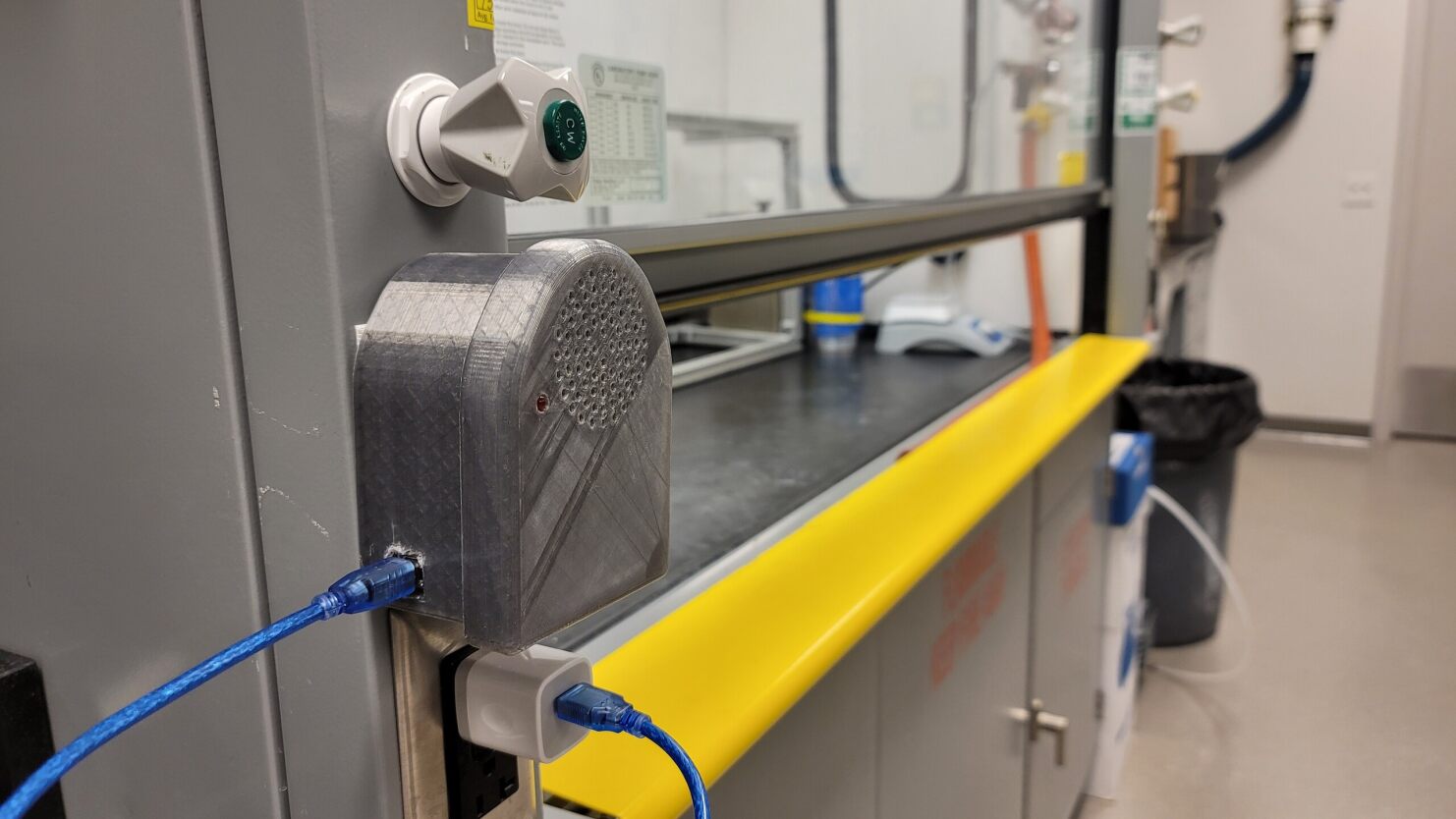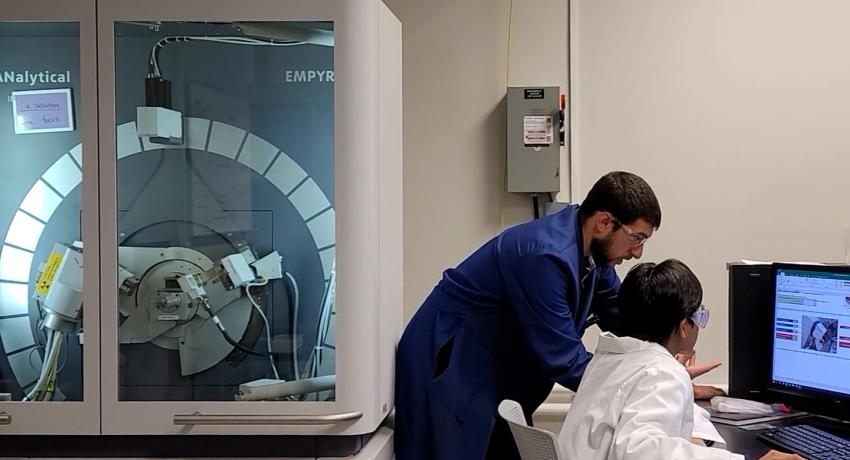Gino Tambourine, technical staff, X-ray/particle/thermal with the Materials Research Institute (MRI), mentors Muhammad Ishak, third-year materials science and engineering and MRI Undergraduate Fellow, on reading research data. Credit: Seana Wood/Penn State MRI.
By Jamie Oberdick
UNIVERSITY PARK, Pa. — One of the more innovative energy-saving tools at Penn State was not implemented by a faculty member, employee, or graduate student. Instead, it was developed by undergraduate students who are part of an innovative and unique research fellowship offered by the Materials Research Institute (MRI).
MRI’s Undergraduate Research Fellowship is unique in that it offers undergraduate students an opportunity to receive training and use the high-end scientific instrumentation available in the Millennium Science Complex. This is something only students at a graduate level usually have access to. Each of the undergraduate fellows are assigned a few main projects for their time working with MRI faculty and research staff, and this included the innovative energy-saving idea, which was a sensor for laboratory fume hoods to make sure the fume hood sash was closed when not in use.
However, the fellowship experience is not limited to their assigned projects. They are exposed to various research projects that enable them to receive hands-on experiential learning working with the over 20 full-time research staff in MRI’s Materials Characterization Laboratory. And beyond this, they also receive opportunities to work with some of the approximately 1,000 researchers from 45 Penn State departments doing cutting-edge research work at the University. They also have opportunities to interact with MRI’s more than 100 external research partners from other higher education institutions and industry, giving them valuable contacts and resume points for future employment and graduate school searches.
The fellowship is the brainchild of its director, Maxwell Wetherington, assistant research professor, molecular spectroscopy. Wetherington was inspired to create the program after recalling his own Penn State student experience, which included earning a bachelor of science degree in engineering science, a master of science degree in material science and engineering, and a doctor of philosophy degree in materials science and engineering.
“I just remember as an undergraduate just wanting to drink out of the fire hose of stuff that's coming out of Penn State, because there's just so many opportunities,” Wetherington said. “I really feel that the experience you get outside of the classroom is equally as valuable as the experience you are getting in the classroom. And so, I did everything I could, when I was an undergraduate, to find hands-on experience opportunities, and that served me well. So that is what I tried to create with MRI Undergraduate Fellowship program.”
Each year, five undergraduate students are selected as fellows. For the 2022-2023 version of the program that ended in May 2023, the students included Muhammad Ishak, third-year materials science and engineering; Harshit Jain, third-year computer science; Jongkyeong Kim, third-year year materials science and engineering; Baaz Misra, second-year computer science and engineering; and Alejandro Toro, third-year material science and engineering.
Kim’s work during his fellowship included the fume hood sensor. He was inspired by some of his sustainability coursework that taught him that fume hoods have some of the greatest impact on energy use in a lab. This is due to the amount of energy required to keep a consistent airflow to remove hazardous fumes in a lab. Closing the sash when the lab is not in use reduces the volume of air that needs to be treated and exhausted, thus saving energy.
Kim researched solutions to ensure the sash is closed and found a Massachusetts Institute of Technology paper that outlined an instrument, the Motion and Sash Height (MASH) sensor that would detect if it were open or not. Kim then took the initiative to create the sensors at Penn State.
“I wrote a proposal, which landed us the funding to build the sensors, and then we modified them to work better with our hoods,” Kim said. “So far we have built six MASH sensors, and they are currently in use, saving energy, in various labs across campus.”

Along with this, Kim also has a passion for researching polymers. His hands-on experience with advanced instrumentation enabled him to apply his enthusiasm for polymers in a lab setting.
"I got to use Fourier-transform infrared spectroscopy in combination with other characterization techniques such as X-ray photoelectron spectroscopy and others to solve polymer and surface-related problems for both Penn State users and external industries,” Kim said. “I also got to work on microplastics, which was great since microplastics are big issues these days. Overall, it was a valuable experience.”
Ishak’s project enabled him to work with a faculty member outside of Penn State, Tom Mallouk, currently the chair of the Department of Chemistry at the University of Pennsylvania. Like Kim, his project had an immediate impact on research at Penn State.
"I worked together with Mallouk to improve the accuracy and reproducibility of our Helium pycnometer, which measures the density and mass of solids, to develop a new, standardized operating procedure for that instrument,” Ishak said.
For Jain, his projects put into practice what he has learned as a computer science major, especially around machine learning and artificial intelligence. One was developing an innovative web application that allows a researcher anywhere in the United States to find a specific research instrument near their location.
"A researcher could be sitting in say Los Angeles and if they wanted to find a particular research instrument near them, they could do a search to find it and also the contact information for the institute that has the instrument they are looking for,” Jain said.
The other computer science-focused Fellow, Misra, credits the program in part with his switching to his current major from electrical engineering.
“As I progressed through my studies, I realized that computer science is something that I'm more passionate about,” Misra said. “And as I did my work at MRI, and explored things like image processing and computer vision, I realized that requires an extraordinarily strong background in computer algorithms, and to a lesser extent computer organization design. I thought, there is a major that exists at Penn State that combines the best part of computer science and the best part of electrical engineering, which sounds like a perfect match for me.”
Misra’s project work included supporting remote transmission electron microscopy, which involves users outside of University Park logging into a system that enables them to control the microscopes remotely.
“I help support this capability, including learning how to operate the microscopes and troubleshoot them, which is important because it takes some time to learn all the machines’ quirks and how to mitigate them for the remote users,” Misra said. “Perhaps most importantly, I’ve learned when to know I can’t solve something, and more advanced maintenance is needed.”
Toro also worked with remote users at Penn State Harrisburg on scanning electron microscopy (SEM) and related focused ion beam work, along with prepping samples to be characterized by these tools.
“Right now, professors at Harrisburg are able to commission projects and research to be done on the SEM microscopes and focused ion beam for their own research,” Toro said. “Through the fellowship, I can save these researchers time and money since they can do this work on our instruments remotely, so they do not have to travel to University Park from Harrisburg.”
All these experiences add up to giving the Fellows the jump on starting their careers. For Toro, it was being able to discuss his new-found hands-on research work at interviews.
“I've been interviewing for a lot of different internships and trying to get the job as a junior and being able to talk about the MRI and some of the work I've done, some of the people I've interacted with, and being able to talk about science at such a high level has been extremely valuable,” Toro said.
Problem solving is an important skill for job seekers. This was what Ishak pointed out was a huge benefit of the program for him.
“One of the most valuable things I got from being a Fellow that I couldn’t get anywhere else is problem-solving skills,” Ishak said. “You have to learn things, you have to figure out how to address issues, produce action steps, things like that, on your own. Just do things by yourself based on what you have learned.”
Along with the research work, the Fellows had plenty of enjoyable team-building activities, such as playing basketball, hiking at nearby Rothrock State Forest, barbequing and playing disc golf. As Wetherington said, “get the students out of the lab and out of the Millennium Science Complex basement for some time to bond together.”
Along with a unique opportunity for the Fellows, Wetherington said the program is also an excellent opportunity for professional development for MRI staff. He noted it enabled the staff members to offer themselves as mentors for the students, effectively creating a year-long apprenticeship.
"We wanted to also provide our senior staff some room to grow professionally and supervise projects that maybe they don't have time to run themselves, but they'd love to see kind of come to fruition,” Wetherington said. “This program is an opportunity to both serve the undergrads and an opportunity to help the senior staff grow into their supervisory role and see new projects come to light in the facility.”
Jain found this mentoring to be a key part of preparing for his career.
“Along with the technical skills I learned, my mentors also helped me with growing skills such as something that has been a sticking point for me, job interviews,” Jain said. “Also, it has been wonderful just being around a lot of great people who are software engineers and other types of researchers who are doing really good things, and in turn are inspiring me to also do things that have a positive impact on society.”
For more information on the program and to learn more about industry sponsorships, contact Wetherington at mtw5027@psu.edu or David Fecko, director of MRI industry collaboration, at dlf5023@psu.edu.

